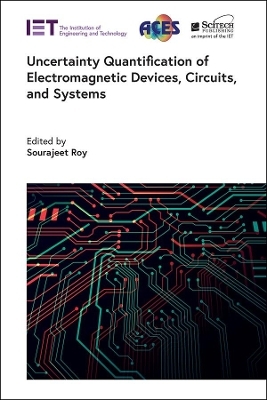
Uncertainty Quantification of Electromagnetic Devices, Circuits, and Systems
Institution of Engineering and Technology (Verlag)
978-1-83953-171-2 (ISBN)
Uncertainty Quantification of Electromagnetic Devices, Circuits, and Systems describes the advances made over the last decade in the topic of uncertainty quantification (UQ) and stochastic analysis. The primary goal of the book is to educate and inform electronics engineers about the most recent numerical techniques, mathematical theories, and computational methods to perform UQ for electromagnetic devices, circuits, and systems.
Importantly, the book offers an in-depth exploration of the recent explosion in surrogate modelling (metamodeling) techniques for numerically efficient UQ. Metamodeling has currently become the most attractive, numerically efficient, and popular approach for UQ.
The book begins by introducing the concept of uncertainty quantification in electromagnetic device, circuit, and system simulation. Further chapters cover the theory and applications of polynomial chaos based uncertainty quantification in electrical engineering; dimension reduction strategies to address the curse of dimensionality in polynomial chaos; a predictor-corrector algorithm for fast polynomial chaos based statistical modeling of carbon nanotube interconnects; machine learning approaches towards uncertainty quantification; artificial neural network-based yield optimization with uncertainties in EM structural parameters; exploring order reduction clustering methods for uncertainty quantification of electromagnetic composite structures; and mixed epistemic-aleatory uncertainty using a new polynomial chaos formulation combined with machine learning. A final chapter provides concluding remarks and explores potential future directions for research in the field.
The book will be a welcome resource for advanced students and researchers in electromagnetics and applied mathematical modelling who are working on electronic circuit and device design.
Sourajeet Roy is an Assistant Professor in the Department of Electronics and Communication Engineering at the Indian Institute of Technology, Roorkee, India where he leads the Computational Modeling and Simulation (CMAS) research group. He has previously worked at Colorado State University as an Assistant Professor from 2013 to 2018. He is a Senior Member of the IEEE and his areas of research include numerical modeling and simulation of high-speed devices/circuits and computational algorithms for uncertainty quantification.
Chapter 1: Uncertainty quantification in electromagnetic device, circuit, and system simulation: its importance and value
Chapter 2: Polynomial chaos based uncertainty quantification in electrical engineering: theory
Chapter 3: Polynomial chaos based uncertainty quantification in electrical engineering: applications
Chapter 4: Dimension reduction strategies to address the curse of dimensionality in polynomial chaos
Chapter 5: A predictor-corrector algorithm for fast polynomial chaos based statistical modeling of carbon nanotube interconnects
Chapter 6: Uncertainty quantification and design optimization with non-Gaussian correlated process variations
Chapter 7: Machine learning approaches towards uncertainty quantification
Chapter 8: Artificial neural network-based yield optimization with uncertainties in EM structural parameters
Chapter 9: Exploring order reduction clustering methods for uncertainty quantification of electromagnetic composite structures
Chapter 10: Mixed epistemic-aleatory uncertainty using a new polynomial chaos formulation combined with machine learning
Chapter 11: Conclusions and future directions
| Erscheinungsdatum | 02.02.2022 |
|---|---|
| Reihe/Serie | Electromagnetic Waves |
| Verlagsort | Stevenage |
| Sprache | englisch |
| Maße | 156 x 234 mm |
| Themenwelt | Naturwissenschaften ► Physik / Astronomie ► Elektrodynamik |
| Technik ► Elektrotechnik / Energietechnik | |
| ISBN-10 | 1-83953-171-1 / 1839531711 |
| ISBN-13 | 978-1-83953-171-2 / 9781839531712 |
| Zustand | Neuware |
| Haben Sie eine Frage zum Produkt? |
aus dem Bereich


